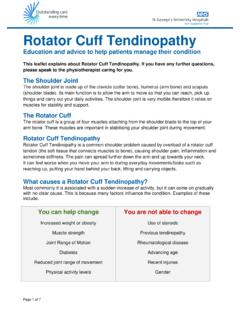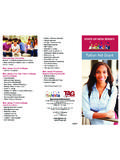Transcription of Cawthorne-Cooksey Exercises - St George's Hospital
1 Cawthorne-Cooksey Exercises Information for patients Department of Audiovestibular Medicine St. George s Hospital 1 Contents: What are cawthorne - cooksey Exercises ? .. 2 How to use the Exercises ? .. 3 exercise set 1 In bed or sitting: .. 4 exercise set 2 Sitting: .. 4 exercise set 3 Standing: .. 4 How to find us .. 5 Contact details: .. 8 2 What are cawthorne - cooksey Exercises ? The balance parts of the two ears complement each other by sending equal impulses to the brain which are essential for the maintenance of equilibrium of the head and body. If either or both balance centres are damaged, equilibrium is upset. The result of this is vertigo or giddiness, which may be accompanied by nausea and vomiting. Although this condition may be very frightening it is not serious, in that it does not, in itself, threaten life. Cawthorne-Cooksey Exercises are special Exercises that can, in many cases, overcome the difficulties experienced with the disequilibrium.
2 The purpose of these Exercises is to build up a tolerance mechanism and the more diligently and regularly they are carried out, the sooner the symptoms will disappear. 3 How to use the Exercises ? The Exercises should be performed for approximately 10 minutes twice daily. You should perform the Exercises daily for maximal benefit. Do not overdo the Exercises . If symptoms become too severe, take a break. Begin with exercise 1. Work your way down the Exercises within the 10 minutes. Should an exercise make you feel off balance, dizzy or unstable, practice this exercise for the remainder of the 10 minutes. Perform the Exercises as directed above on each occasion. Do not proceed with the other Exercises until you are able to comfortably do the exercise in question without symptoms. Follow the above until you are able to perform all Exercises and keep active on the long term. Try to incorporate some of the principles in your everyday life if possible.
3 You could restart Exercises if your symptoms ever return. 4 exercise set 1 In bed or sitting: 1. Eye movements Start slowly and then move quicker a. Up and down b. From side to side c. Focusing on finger moving from 60cm to 30cm away from face 2. Head movements Start slowly and then move quicker. Later try with eyes closed. a. Bending forward and backward b. Turning from side to side. exercise set 2 Sitting: 1. Eye movements and head movements as above 2. Shoulder shrugging and circling 3. Bending forward and picking up objects from the ground exercise set 3 Standing: 1. Eye, head and shoulder movements as above 2. Changing from sitting to standing position with eyes open and shut 3. Throwing a small ball from hand to hand above eye level 4. Throwing a small ball from hand to hand under the knee 5. Changing from sitting to standing and turning around in between 5 How to find us By Bus Bus routes 493 and G1 enter the grounds of St George's Hospital .
4 Several other bus routes serve roads within a short walk of the Hospital . Routes 44, 77, 270, N44 stop on Garratt Lane, routes 57, 131. 219, and N155 stop on Tooting high street, and routes 155, 264 and 280 stop on Blackshaw road. Low-floor, wheelchair accessible buses run on all routes. 6 By Bike Free cycle parking facilities can be found at a number of locations on the Hospital perimeter road. St George's Hospital appears in Local Cycling Guides 10 and 14. You can order a free copy of these guides online at or by calling 0843 222 1234. By Car If you are driving to the Hospital , entry points are on Blackshaw Road, off the A24 Tooting High Street, or Fountain Road, off the A217 Garrett Lane. Car parking Car parking is pay upon exit and the tariff is as follows: Up to one hour Up to two hours Up to three hours Up to four hours Up to five hours Up to six hours Up to seven hours Up to eight hours Over eight hours (daily fixed rate) 7 St George s Healthcare NHS Trust operates a civil penalty parking notice scheme on the St George s Hospital site.
5 Please check sign for parking restrictions. Blue badge holders may park free in: Any of the reserved disabled spaces available near the entrances of the Hospital wings - please display your badge Any white-painted bay on the Hospital perimeter road - please display your badge The public car parks. The badge holder must take the car park ticket and blue badge to the security desk in Grosvenor Wing or the reception desk in Atkinson Morley Wing before they leave the Hospital . The staff will tell the badge holder how to exit the car park without paying. It is not necessary to display you badge when in the car parks If you need assistance on arrival, please tell the main Hospital reception staff. They can arrange for a porter to help you, though please understand you may have to wait for this 8 Contact details: Appointment Line: 020 8266 6363 Department of Audiovestibular Medicine Lanesborough Wing St.
6 George s Hospital Blackshaw Road London SW17 0QT Enquiries: 020 8725 1151 Fax: 020 8266 6255 Minicom: 020 8725 3019













